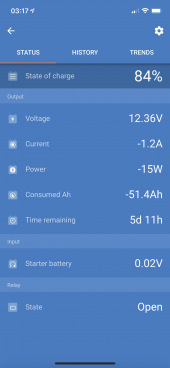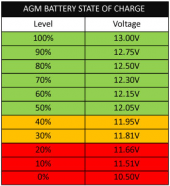Thanks for the config summary very useful!
Yeah, but I'm wondering what "100% - 80%" means for battery health in the context of degraded batteries and a calibrated scale. I guess I'm doing the best I possibly can for them, save for not using them at all!
I was also thinking....given my batteries are starter batteries, do you think it's possible that my batteries aren't actually degraded
No. A year's worth of use would degrade any lead-acid battery, deep cycle, starter, FLA, AGM, Gel, etc.
, but should be derated for solar cycle usage? I.e. 80Ah is only applicable in the context of starting an engine. Just a thought.
Probably, but derating translates to actually utilizing them less, i.e., lower currents and lower rates of discharge/charge, not just a capacity derating.





